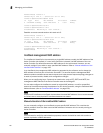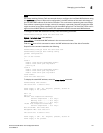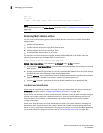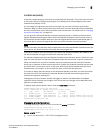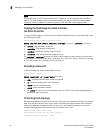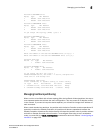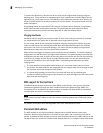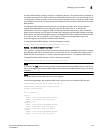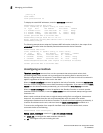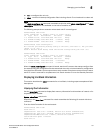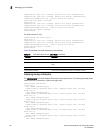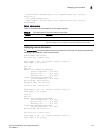
128 PowerConnect B-Series FCX Configuration Guide
53-1002266-01
Managing your IronStack
5
To reverse the partitioning, reconnect all of the units into the original stack topology using the
stacking ports. This is the same as merging stacks. If the original Active Controller again has the
highest priority, it will regain its role. If two partition Active Controllers have the same priority, the
Active Controller with the most stack members will win the election. This process helps minimize
traffic interruption.
Ring topology stacks do not partition in the event of a member failure. Operation is interrupted
briefly while the stack recalculates a new path. Ring topologies are more stable than linear
topologies because they provide redundant pathways in case of accidental failure.
Merging IronStacks
IronStacks may be merged, but the total number of stack units must not exceed 8. For example,
you could combine two stacks with 4 units each into a single stack of 8 units.
You can merge stacks by connecting them together using the stacking ports. Before doing this,
make sure that none of the stacking ports have been reconfigured as data ports (for example,
ports on an end unit in a linear stack topology). You cannot use secure-setup to merge stacks
because secure-setup does not work across stack boundaries.
When stacks are merged, an election is held among the Active Controllers. The winner retains its
configuration and the IDs of all of its original stack members. The remaining stack units lose their
configuration and are reset. If the IDs of the losing stack units conflict with the IDs of the winning
units they may change, and the IDs will no longer be sequential. You can use secure-setup to
renumber the members in the newly merged stack. The following examples show how stack
merging works:
• If a stack partitions into multiple stacks because of a connection failure, and you fix the
connection, the stack partitions will merge back into the original stack with no change to stack
IDs, because in this case all stack IDs are distinct.
• In a linear stack topology, the end units of the stack will have only one stacking port
configured. Before you can merge two linear stacks, you must reconfigure the end units so that
both ports are stacking ports.
MIB support for the IronStack
All statistics about packets received and sent, RMON, jumbo frames, runts, giants, and other
instances are gathered through the stack interfaces and are accessible through SNMP. The
functionality for an IronStack is the same as that for a standard 10 Gbps interface. Information
includes types of modules, including optics modules.
NOTE
A type counter has been added to count the number of packets greater than 1518 bytes (jumbo
frames).
For detailed information about stacking MIBs, refer to the MIB Reference Guide.
Persistent MAC address
The MAC address for the entire IronStack is determined by the MAC address of the Active
Controller. When an Active Controller is removed from the stack, and a new Active Controller is
elected, by default the MAC address of the new Active Controller becomes the MAC address for the
IronStack. When you enable the Persistent MAC Address feature, you configure a time delay before



